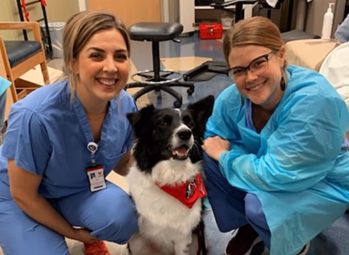Research Articles
Canelo, Elsa. (2020). Perceptions of Animal Assisted Reading and its Results Reported by Involved Children, Parents and Teachers of a Portuguese Elementary School. In Human-Animal Interaction Bulletin, Vol. 8, No. 3, 92-110. PDF
Onishi, Ena. (March 2017). Social Role of Animal Assisted Education (AAE) in Japan and their Tasks. PDF
Brelsford, Victoria L., Meints, Kerstin, Gee, Nancy R., and Pfeffer, Karen. (2017). Animal-Assisted Interventions in the Classroom – A Systematic Review. PDF
Hall, S.S. Gee, N.R., Mills D.S. (2016). Children Reading to Dogs: A Systematic Review of the Literature. PLoS ONE 11(2): e0149759. VIEW
Lenihan, D., McCobb, E., Diurba, A., Linder, D., and Freeman, L. (2016). Measuring the Effects of Reading Assistance Dogs on Reading Ability and Attitudes in Elementary Schoolchildren. In J Res Child Educ. 2016 ; 30(2): 252–259. doi:10.1080/02568543.2016.1143896. VIEW
Fostering Literacy Learning with Three Middle School Special-Education Students Using Therapy Dogs as Reading Partners by Lamkin, Donna, Ph.D., State University of New York at Albany, 2017, 272; 10683497 VIEW
Effects of Reading with Adult Tutor/Therapy Dog Teams on Elementary Students’ Reading Achievement and Attitudes, by Levinson, Vogt, Barker, Jalongo and Van Zandt, published April 2017 by the Animals & Society Institute brill.com/soan | PDF
leRoux, Marieanna C., Leslie Swartz and Estelle Swart (2014). The Effect of an Animal-Assisted Reading Program on the Reading Rate, Accuracy and Comprehension of Grade 3 Students: A Randomized Control Study, in Child Youth Care Forum, 43L655-673. PDF
Canine Visitors: The Influence of Therapy Dogs on Young Children’s Learning and Well-Being in Classrooms and Hospitals PDF
Lane, H. B., Zavada, S.D. (2013). When Reading Gets Ruff: Canine-Assisted Reading Programs. The Reading Teacher, International Reading Association, Vol 67, Issue 2.
Friesen, L. (2013). The Gifted Child as Cheetah: A Unique Animal-Assisted Literacy Program. The Latham Letter, Vol. XXXIV, No. 1, pp. 6-10, Winter 2013. PDF
Shaw, Donita Massengill (2013). Man’s Best Friend as a Reading Facilitator. The Reading Teacher (publication of the International Reading Association), Vol. 66, Issue 5, pp. 365-371. www.reading.org | PDF
Friesen, L. (2012). Animal-assisted literacy learning as carnival: A Bakhtinian analysis. The International Journal of Learning, 18(3),305-324.
Friesen, L. & Delisle, E. (2012, March/April). Animal-assisted literacy: A supportive environment for constrained and unconstrained learning. Childhood Education International, 102-107.
Friesen, L. (2010). Animals in children’s literature: A powerful motivator for literacy learning. Focus on Elementary: Association for Childhood Education International, 22(2), 1-7.
Friesen, L. (2009). Exploring animal-assisted programs with children in school and therapeutic contexts. Early Childhood Education Journal, 37(4), 261-267.
Friesen, L. (2009). How a therapy dog may inspire student literacy engagement in the elementary language arts classroom. [Special issue.] LEARNing Landscapes, 3(1), 105-122.

